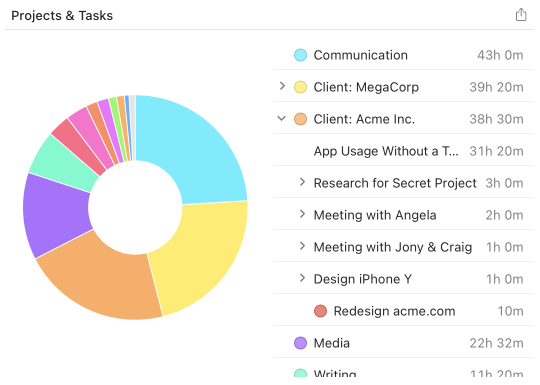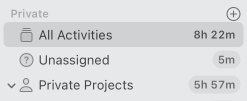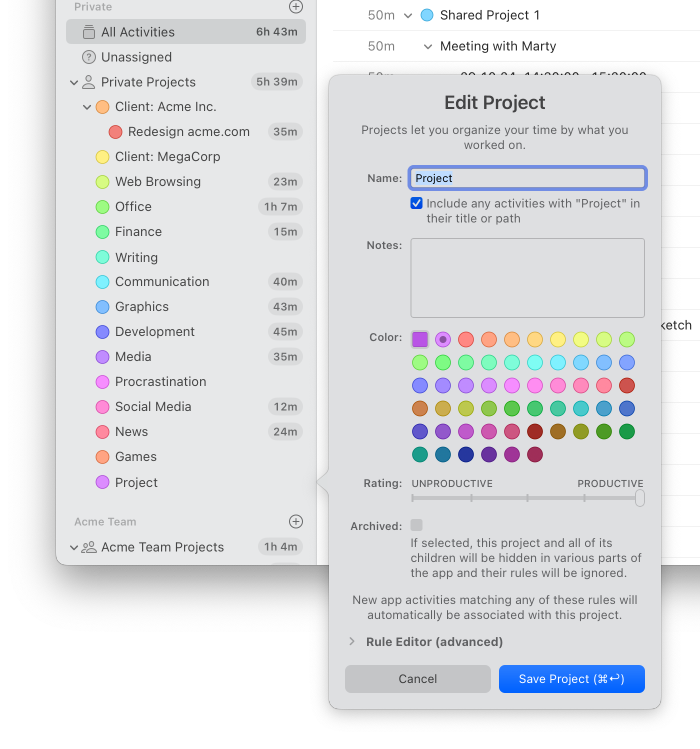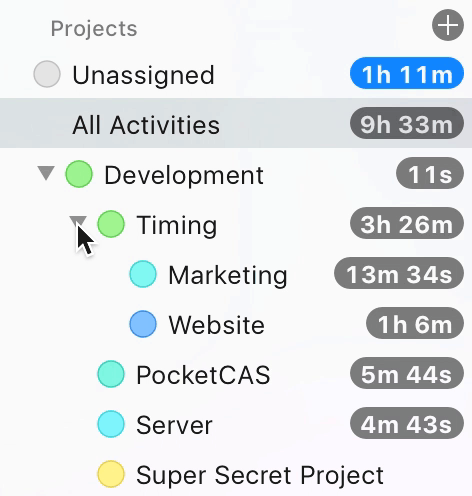Projects
Timing's automatic time tracking is great for recording which apps, documents, and websites you have been using. But that information is so fine-grained that it is easy to miss the bigger picture:
What have you actually worked on?
That's where "projects" come into play. Projects are simply buckets of time that you can assign your app usage and time entries to. Once you've done that, these times will count towards that project's total in various reports throughout the app, giving you a quick high-level overview of what you spent your time on. For example, the "Overview" screen shows how your time is distributed across projects:

While Timing calls them "Project", you can also use them for any other thing you want to record time for, such as freelancing clients, actual projects you work on, or individual activities that you do for work (e.g. "Research"). How you structure your projects is entirely up to you, but for freelancers a three-tier project structure ("Clients" containing "Projects" containing "Sub-Projects" or individual time entries) as outlined in this article has proven successful. Read on for instructions on how to actually create such sub-projects.
Table of Contents
Creating a Project
Let's start by creating a project. To achieve that, let's create a project by clicking the '+' button in the sidebar's project list:

Don't worry about all the fields in the dialog that pops up; we'll get to those later. Just enter a title and press "Create Project".
Here's a quick tip on setting up your project structure: Start with a few "coarse" projects, and only add finer-grained projects when you need them. If you start out with too many projects, they might start to "overlap" with one another. This can lead to confusion on which activities belong where, resulting in inconsistent project assignments.
Assigning Time to Projects
Now that we have our first custom project, let's talk about how you actually assign time to it.
The easiest way is to simply drag an item from one of Timing's activity lists onto a project:
In addition, whenever you create a time entry, the entire timespan of that entry will be associated with the project you select for the entry. There are plenty of ways to create time entries; you can find them all in the documentation on time entries.
Creating Rules
Dragging the same kinds of activities onto the same projects gets old very quickly. That's why Timing lets you create rules: when you keep the ⌥ key pressed while dragging an activity onto a project, Timing will automatically assign all future activities of this kind to that project as well.
In addition, when you create a new project, Timing offers to automatically add a rule to match times containing the project's name in their title or path to the new project. This saves you time categorizing activities and/or creating rules manually, as e.g. all times spent in a folder for that project would automatically be assigned to the project, without any extra effort on your part.
That brings us to an important caveat: project rules (as opposed to filter rules) only apply to future activities, but not past activities (i.e. ones that have been recorded already). However, Timing provides an option to re-apply project rules to past activities; please have a look at our rules documentation for more information on that.
You can compose even more powerful rules manually using Timing's rule editor; please refer to the corresponding knowledge base article on rules for more details.
The Project Editor
When you had created your first project above, you already had a brief encounter with the project editor.
You can also trigger it by double-clicking an existing project in the sidebar:

It lets you edit all the project's properties:
- Picking a name for the project should be self-explanatory.
-
You also have the option toautomatically add a rule to match times
containing the project's name in their title or path to the new project. This saves you time
categorizing activities and/or creating rules manually, as e.g. all times spent in a folder for that
project would automatically be assigned to the project, without any extra effort on your part.
Under the hood, this will simply create a "Title or Path contains 'Project Name'" rule for you; you can always edit or delete this rule later. - Notes let you quickly jot down any information you might need to remember about the project. This is intended more as a quick reference for yourself than for long-form notes, though.
- You can also pick a color for the project. The first button opens a panel that lets you pick an arbitrary color, while the other colored dots allow you to pick from a selection of predefined colors.
- Each project also has a productivity rating.
Timing uses this rating to compute your productivity score on the Overview screen.
New projects start with a "neutral" productivity rating, so you might want to adjust this. - If you select the option to archive a project, it will be hidden from the project list and its rules will be ignored.
- If you have enabled billing status tracking, you can also set a default billing status for the project. This determines what billing status new time entries in this project will have by default (e.g. "Billable" for client work, "Not Billable" for internal projects). You can choose "Automatic" to inherit the default from the project's parent, from your team's default (if the project belongs to a team), or from your global preferences.
- If you want to make manual changes to the project's rule, click the triangle next to Rule Editor.
In that case, please make sure to read our in-depth article on editing rules.
The "Unassigned" Pseudo-Project
Once you have assigned a substantial portion of your time to various projects, it becomes more difficult to figure out which times you have not assigned yet. The "Unassigned" pseudo-project makes this easier by showing you only the activities that do not belong to any project yet. Simply select "Unassigned" in the sidebar to enable this filter, then start assigning the activities you see in your lists.
Rearranging Projects
Often, one big "Project" actually consists of several smaller parts.
To reflect this relationship in Timing, you can drag other projects onto a project to add them as sub-projects.
Alternatively, when you create a new project by clicking the '+'
button while another project is selected, it will be added as a sub-project to the selected one.
If you want to include a project's sub-projects in its total time, try collapsing the parent project via the triangle next to it:
 Alternatively, you can ⌘- or ⇧-click on the project list to select multiple projects at once.
Alternatively, you can ⌘- or ⇧-click on the project list to select multiple projects at once.
Archiving Projects
Over time, your project list might get cluttered with entries that are no longer relevant, such as past clients. For this case, Timing offers the option to mark a project as "archived". Once you've done that via the project's context menu or editor, Timing will automatically hide it from the project list and stop applying rules for it. You will also no longer see time entry title suggestions for that project, which should make finding the project you actually need when starting a new timer easier.
And if you ever need to show archived projects again, you can do so by selecting the "Show Archived Projects" option from either the "View" menu or the project list's context menu.